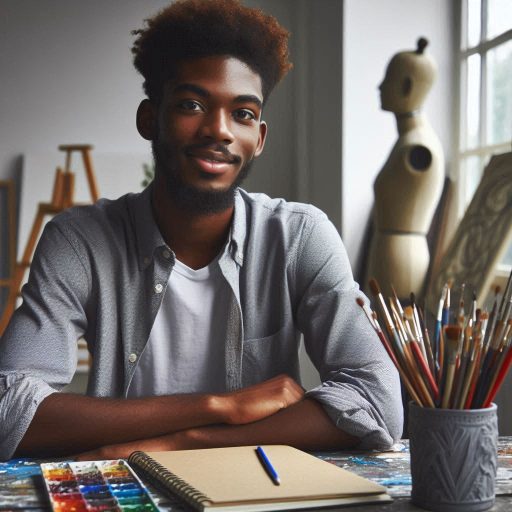Introduction
We will be talking about Technology in Art Education in this blog post.
Integrating technology in art education is crucial for empowering students with modern skills.
Technology provides tools for students to explore and experiment with various artistic techniques.
It enhances creativity by allowing students to take risks and push boundaries in their artwork.
Technology enables students to access a wide range of resources and references for inspiration.
It also facilitates collaboration among students, teachers, and artists from around the world.
By using digital tools, students can receive immediate feedback on their work and make improvements.
Overall, technology integration in art education fosters innovation, critical thinking, and digital literacy skills.
Benefits of integrating technology in art education
When it comes to art education, integrating technology has numerous benefits that can enhance the learning experience for students:
Increased Engagement and Motivation Among Students
One of the main advantages of incorporating technology in art education is the ability to increase student engagement and motivation.
By using digital tools and platforms, educators can create interactive and dynamic lessons that capture the interest of students.
Opportunities for Collaboration and Sharing of Ideas
Technology opens up a world of possibilities for collaboration in art education.
Students can work together on projects, share their work with peers, and even connect with artists from around the globe.
This collaborative aspect fosters creativity and teamwork skills.
Access to a Wide Range of Resources and Tools for Creating Art
By integrating technology, students have access to a wealth of resources and tools that can enhance their artistic abilities.
From digital drawing programs to online museums and galleries, technology provides endless opportunities for students to explore different mediums and styles of art.
In fact, integrating technology in art education offers a host of benefits that can revolutionize the way students learn and create art.
By harnessing the power of digital tools, educators can inspire creativity, collaboration, and engagement in the classroom.
Read: Sustainable Practices in Costume Design
Examples of technology used in art education
Integrating technology in art education has opened up a world of possibilities for both teachers and students.
Transform Your Career Today
Unlock a personalized career strategy that drives real results. Get tailored advice and a roadmap designed just for you.
Start NowBy leveraging digital tools, educators can enhance creativity, collaboration, and engagement in the learning process.
Digital Drawing Tablets
Digital drawing tablets provide students with a hands-on experience that mimics traditional drawing techniques while offering the benefits of digital technology.
These devices enable artists to experiment with different mediums, colors, and textures without the need for physical materials.
3D Modeling Software
3D modeling software allows students to create intricate designs and sculptures in a virtual environment.
This technology enables artists to visualize their ideas in three dimensions, explore spatial relationships, and test different configurations before bringing their creations to life.
Virtual Reality Programs
Virtual reality programs offer immersive art experiences by transporting students to virtual galleries, museums, and landscapes where they can interact with art in new and exciting ways.
This technology allows artists to explore different perspectives, experiment with novel concepts, and push the boundaries of traditional art forms.
By incorporating digital drawing tablets, 3D modeling software, and virtual reality programs into art education, educators can empower students to explore their creativity, develop technical skills, and engage with art in innovative ways.
These technologies not only enhance the learning experience but also prepare students for a digital future where technology plays an integral role in the art world.
Read: Effective Teaching Methods for Art Educators
Challenges in Integrating Technology in Art Education
Integrating technology in art education presents several challenges that need to be addressed in order to maximize its benefits for students.
Some of the key challenges include:
Initial costs of purchasing technology and software
One of the main obstacles to integrating technology in art education is the initial investment required to purchase the necessary hardware and software.
Schools may not always have the budget to acquire the latest technology, which can limit access to new tools and resources for students.
Training teachers to effectively use technology in the classroom
Another challenge is providing adequate training and professional development for teachers to effectively integrate technology in their art curriculum.
Teachers need to be proficient in using technology tools and software to enhance their teaching methods and engage students in creative activities.
Ensuring equitable access to technology for all students
Equity in access to technology is a critical issue in art education, as not all students may have the same resources at home or in their communities.
Schools need to ensure that all students have equal opportunities to use technology tools and participate in digital art projects, regardless of their socioeconomic background.
Addressing these challenges requires a collaborative effort from school administrators, teachers, parents, and policymakers.
Read: Costume Design: Collaborating with Directors
Transform Your Career Today
Unlock a personalized career strategy that drives real results. Get tailored advice and a roadmap designed just for you.
Start Now
Strategies for successful integration of technology in art education
When it comes to incorporating technology in art education, there are several key strategies that can help ensure successful integration:
Providing professional development for teachers on using technology
One of the most important factors in successfully integrating technology in art education is ensuring that teachers are equipped with the knowledge and skills to effectively use technology in their teaching.
This may involve providing professional development opportunities, workshops, and training sessions that focus on the specific tools and software that can enhance the creative process in the art classroom.
Encouraging creativity and experimentation with different tools
Another crucial strategy for successful integration of technology in art education is to encourage students to explore and experiment with a variety of digital tools and software.
By fostering creativity and allowing students to explore different mediums and techniques, teachers can help students develop their artistic skills while also gaining confidence in using technology as a creative tool.
Incorporating technology in project-based learning activities
Project-based learning activities are a great way to incorporate technology in art education.
By integrating technology into project assignments, students can work collaboratively, problem-solve, and create multimedia projects that showcase their artistic talents.
This hands-on approach allows students to engage with technology in a meaningful way, while also honing their artistic abilities and critical thinking skills.
In a nutshell, successful integration of technology in art education requires a multi-faceted approach that includes providing professional development for teachers, encouraging creativity and experimentation with different tools, and incorporating technology in project-based learning activities.
By implementing these strategies, educators can help students develop their artistic skills and creativity in a digital age.
Read: How to Build a Portfolio for Art Teaching
Impact of technology on the future of art education
Technology has revolutionized the way art is taught and learned, shaping the future of art education in numerous ways.
Preparation of students for careers in digital art and design
Integrating technology in art education equips students with the necessary skills for careers in digital art and design.
Students are exposed to digital tools and software used in the industry, giving them a competitive edge in the job market.
They learn how to create digital art, manipulate images, and design graphics, preparing them for diverse career opportunities.
Integration of technology in traditional art practices
Technology enhances traditional art practices by offering new tools and techniques for artists to explore and experiment with.
Artists can use digital platforms to sketch, paint, sculpt, and create art in ways that were previously not possible.
They can blend traditional and digital mediums to produce innovative artworks that push the boundaries of creativity.
Shift towards online learning platforms for art education
Art education is moving towards online platforms, allowing students to access art courses and resources from anywhere in the world.
Online platforms offer interactive lessons, tutorials, and workshops that cater to diverse learning styles and preferences.
Transform Your Career Today
Unlock a personalized career strategy that drives real results. Get tailored advice and a roadmap designed just for you.
Start NowStudents can engage with art educators, collaborate with peers, and showcase their work in virtual galleries, fostering a sense of community and connection.
All in all, technology is shaping the future of art education by preparing students for digital careers, enhancing traditional art practices, and providing access to online learning platforms.
Conclusion
Integrating technology in art education brings numerous benefits.
It enhances creativity, collaboration, and digital literacy skills.
Furthermore, it provides access to a wide range of resources, tools, and platforms that can inspire students to explore and experiment with new artistic techniques.
However, challenges such as access to technology, digital divide, and technical issues may hinder the seamless integration of technology in art education.
Despite these challenges, it is crucial to prepare students for a tech-driven future in the art world. Technology is reshaping the way art is created, shared, and enjoyed.
By equipping students with the necessary digital skills and knowledge, educators can empower them to thrive in a constantly evolving art landscape.
It is about fostering creativity, critical thinking, and adaptability in students.
As technology continues to shape the art world, it is essential for educators to embrace innovation and prepare students for success in a tech-driven society.
[E-Books for Sale]
The Big Book of 500 High-Paying Jobs in America: Unlock Your Earning Potential
$19.99 • 500 High-Paying Jobs • 330 pages
Explore 500 high-paying jobs in America and learn how to boost your career, earn more, and achieve success!
See All 500 High-Paying Jobs of this E-Book
1001 Professions Without a Degree: High-Paying American Jobs You Can Start Now
$19.99 • 1001 Professions Without a Degree • 174 pages
Discover 1001 high-paying jobs without a degree! Unlock career tips, skills, and success strategies for just $19.99!




